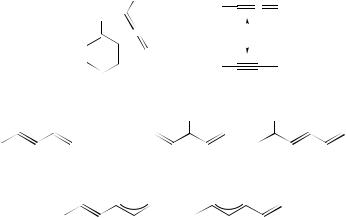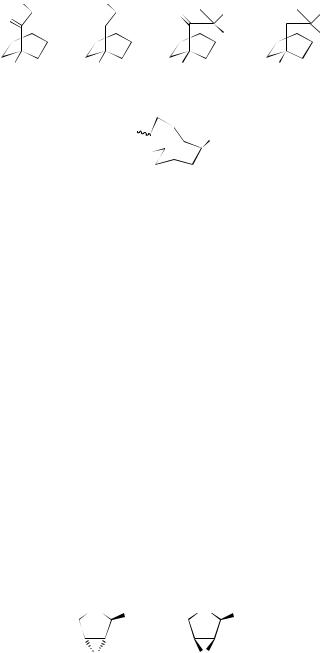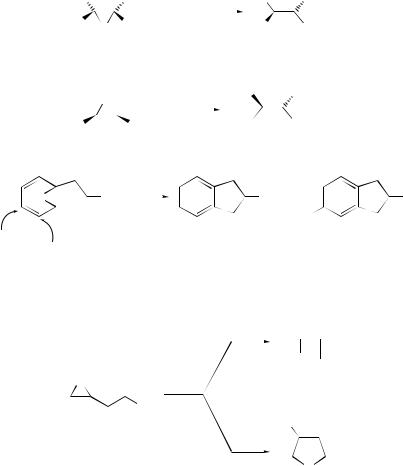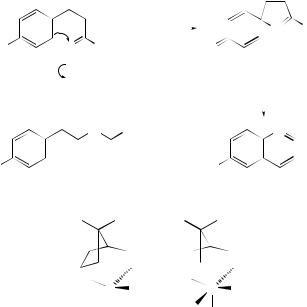
Organic reaction mechanisms. 1998 / 10
.pdf
Organic Reaction Mechanisms - 1998: An Annual Survey Covering the Literature Dated December 1997 to November 1998. Edited by A. C. Knipe and W. E. Watts Copyright ∂ 2003 John Wiley & Sons, Ltd.
ISBN: 0-471-49017-2
CHAPTER 10 |
|
Nucleophilic Aliphatic Substitution |
|
J. SHORTER |
|
Department of Chemistry, University of Hull |
|
Vinylic Systems . . . . . . . . . . . . . . . . . . . . . . . . . . . . . . . . . . . . . . . . . . . . |
323 |
Allylic and Other Unsaturated Systems . . . . . . . . . . . . . . . . . . . . . . . . . . . |
324 |
Norbornyl and Closely Related Systems . . . . . . . . . . . . . . . . . . . . . . . . . . . |
326 |
Epoxide Reactions . . . . . . . . . . . . . . . . . . . . . . . . . . . . . . . . . . . . . . . . . . |
326 |
Other Small Rings . . . . . . . . . . . . . . . . . . . . . . . . . . . . . . . . . . . . . . . . . . |
330 |
Substitution at Elements Other than Carbon . . . . . . . . . . . . . . . . . . . . . . . . |
331 |
Intramolecular Substitution . . . . . . . . . . . . . . . . . . . . . . . . . . . . . . . . . . . . |
332 |
Ambident Nucleophiles . . . . . . . . . . . . . . . . . . . . . . . . . . . . . . . . . . . . . . . |
335 |
Alpha Effect . . . . . . . . . . . . . . . . . . . . . . . . . . . . . . . . . . . . . . . . . . . . . . |
335 |
Isotope Effects . . . . . . . . . . . . . . . . . . . . . . . . . . . . . . . . . . . . . . . . . . . . . |
335 |
Gas-phase Reactions . . . . . . . . . . . . . . . . . . . . . . . . . . . . . . . . . . . . . . . . . |
335 |
Radical Processes . . . . . . . . . . . . . . . . . . . . . . . . . . . . . . . . . . . . . . . . . . . |
338 |
Medium Effects . . . . . . . . . . . . . . . . . . . . . . . . . . . . . . . . . . . . . . . . . . . . |
338 |
Phase-transfer Catalysis and Other Intermolecular Effects . . . . . . . . . . . . . . |
341 |
Structural Effects . . . . . . . . . . . . . . . . . . . . . . . . . . . . . . . . . . . . . . . . . . . |
342 |
Miscellaneous S N2 Reactions . . . . . . . . . . . . . . . . . . . . . . . . . . . . . . . . . . . |
343 |
Miscellaneous Kinetic Studies . . . . . . . . . . . . . . . . . . . . . . . . . . . . . . . . . . |
344 |
Acknowledgement . . . . . . . . . . . . . . . . . . . . . . . . . . . . . . . . . . . . . . . . . . . |
344 |
References . . . . . . . . . . . . . . . . . . . . . . . . . . . . . . . . . . . . . . . . . . . . . . . . |
344 |
Vinylic Systems
Rappoport and co-workers’ work has continued in a study of the substitution of (E)- and (Z)-β-bromo- or chloro-styrenes, (1) and (2), by MeS− in DMSO-d6 (sometimes in admixture with CD3OD) as solvent.1 Product studies indicated retention stereochemistry; rate measurements found only a small Br/Cl element effect, slower reactions of the p-OMe bromo compounds, and retardation by CD3OD. These results are consistent with Tiecco’s suggestion in 1983 that even this system, activated by only a single phenyl group, reacts through the nucleophilic addition–elimination multistep route.
Ochiai’s group has continued work on the nucleophilic vinylic substitutions of alkenyl(phenyl)iodonium salts. (The leaving-group ability of the phenyliodonio group is about 106 times greater than that of triflate.)2 – 4 Reactions of (Z)-(β-chloroalkenyl)- and (Z)-(β-bromoalkenyl)-iodonium tetrafluroroborates (3) with sodium benzenesulfinate in THF yielded the (Z)-1,2-bis(benzenesulfonyl)alkene (4) stereoselectively with retention of configuration.2 Intermediate formation of (Z)-[β-(benzenesulfonyl)alkenyl]
323

324 |
|
|
|
Organic Reaction Mechanisms 1998 |
||
Ph |
H |
Ph |
|
X |
||
C |
|
C |
|
C |
|
C |
|
|
|
||||
|
|
|
||||
H |
X |
H |
|
H |
||
(1) |
|
|
(2) |
|||
X = Br or Cl
RH
|
|
|
|
|
|
|
C |
|
|
C |
+ |
BF4− |
|
|
|||||||
|
|
|
|
|
|
|
|
|
|
|
|||||||||||
|
|
|
|
|
|
|
|
|
|
|
|||||||||||
|
|
|
|
|
|
|
X |
|
|
|
|
|
|||||||||
|
|
|
|
|
|
|
(3) |
IPh |
|
|
|||||||||||
|
|
|
|
|
|
|
|
|
|
|
|
|
|
|
|
|
|
|
|||
|
|
|
|
|
|
|
R = n-C8H17 |
X = Br or Cl |
|
|
|||||||||||
|
|
R |
H |
|
|
|
R |
|
|
|
|
H |
|
|
|||||||
|
|
|
C |
|
C |
|
|
|
|
|
|
C |
|
|
C |
|
|
||||
|
|
|
|
|
|
|
|
|
|
|
|
||||||||||
|
|
|
|
|
|
|
|
|
|
|
|
||||||||||
|
|
PhSO2 |
O2SPh |
|
|
PhSO2 |
|
|
|
+ |
|
X− |
|||||||||
|
|
|
|
|
|
|
|
IPh |
|||||||||||||
|
(4) |
|
|
|
|
|
|
|
(5) |
|
|
|
|
|
|
||||||
R |
|
H |
R |
|
|
|
X |
|
|
|
|
|
|
|
|
|
|||||
C |
|
C |
|
X− |
C |
|
|
C |
+ |
|
R |
|
|
C |
|
C |
|
H + PhI |
|||
|
|
|
|
|
|
|
|
|
|
||||||||||||
H |
+ |
|
|
|
|
H |
|
|
|
H |
|
|
|
|
|
|
|
|
|
||
|
IPh |
|
|
|
|
|
|
|
|
|
|
|
|
||||||||
|
(6a) |
(6b) |
|
|
|
|
|
(6c) |
|
(6d) |
|||||||||||
R = n-C8H17 |
X = Cl, Br, I, F |
|
|
|
|
|
|
|
|
|
|||||||||||
iodonium salt (5) was shown by PMR experiments in CDCl3. The formation of (5) involves a hitherto unobserved Michael addition of benzenesulfinate anion to the alkenyliodonium salts at the β-C, followed by extrusion of halogen.
Reactions of (E)-1-decenyl(phenyl)iodonium salt (6a) with halide ions have been examined under various conditions.3 The products are those of substitution and elimination, usually (Z)-1-halodec-1-ene (6b) and dec-1-yne (6c), as well as iodobenzene (6d), but F− gives exclusively elimination. In kinetic studies of secondary kinetic isotope effects, leaving-group substituent effects, and pressure effects on the rate, the results are compatible with the in-plane vinylic mechanism for substitution with inversion. The reactions of four (E)-β-alkylvinyl(phenyl)iodonium salts with Cl− in MeCN and other solvents at 25 ◦C have been examined.4 Substitution with inversion is usually in competition with elimination to form the alk-1-yne.
Allylic and Other Unsaturated Systems
The work of Ochiai’s group on nucleophilic vinylic substitution of phenyliodonium salts (see previous section) has been extended to examining the behaviour of allenyl (aryl)iodine(III).5 Ratios of nucleophilic substitution to [3,3]-sigmatropic rearrangement for the collapse of allenyl(aryl)iodine(III), generated from the reactions of aryliodanes

10 Nucleophilic Aliphatic Substitution |
325 |
with propargylsilanes in the presence of BF3 –Et2O in alcohols, have been determined. A suggested mechanism involves generation of propargyl cations (8), via a unimolecular pathway from the allenyl(aryl)iodonium ion (7).
The regioand stereo-chemistry of the nucleophilic attack of (S)-trans-hex-3-en-2-ol and (S)-trans-hex-4-en-3-ol on the corresponding O-protonated or -methylated derivatives have been examined in the gas phase at 40 ◦C and 720 Torr.6 Firm evidence of various kinds was obtained for the concerted SN2 pathway accompanying the classical SN2 mechanism. Competition between the two processes is essentially governed by the orienting properties of the oxonium intermediate towards the approaching nucleophile. Many other details were elucidated.
The substitution reaction of Cl− with methyl chloride, 2-chloroethyl radical, and allyl chloride has been treated by several different ab initio theoretical models.7 Depending on the method, the intrinsic barrier for the SN2 process in allyl chloride is 7–11 kcal mol−1 higher than the barrier for the SN2 reaction of methyl chloride. The reaction of Cl− with the 2-chloroethyl radical involves an intermediate complex, which is best described as an ethylene fragment flanked by a resonating chloride anion–chloride radical pair. There are many other points of interest.
|
|
|
|
|
R |
+ |
• |
|
|
|
I+ |
|
R |
|
|
||
|
|
|
|
|
|
|
||
|
|
|
|
|
• |
|
|
|
X |
|
|
|
|
|
|
|
|
|
|
|
|
R |
+ |
|||
|
|
|
||||||
(7) |
|
|
(8) |
|||||
|
|
|
||||||
|
OAc |
|
OAc |
|
|
OAc |
||
(9) |
|
|
|
(10) |
(11) |
|||
|
|
|
|
PdLn |
PdLn |
|||
|
|
|
|
|
|
|
|
|
(12) |
|
|
(13) |
|||||
The effect of the nature of ion pairs as nucleophiles in a metal-catalysed substitution reaction has been investigated by determining product ratios for the Pd-catalysed allylic alkylations of substrates (9)–(11) under various conditions, particularly with respect to catalyst ligands, nucleophiles, and counterions.8 Each dienyl acetate ionizes to form initially the vinyl (π -allyl)–Pd intermediate corresponding most closely to the leaving group, i.e. (12) from (9), (13) from (11), but (12) and (13) from (10). The initial intermediate can then either be trapped by the nucleophile or it can begin to equilibrate to some mixture of vinyl π -allyl intermediates. If nucleophilic addition occurs before full equilibration, the product ratio is different for each substrate; if

326 |
Organic Reaction Mechanisms 1998 |
equilibrium is reached from all three substrates prior to nucleophilic addition, then the product ratio is the same for each substrate. This unified mechanism provides the framework for interpreting the effects of ligands, nucleophiles, and counterions. Any role for SN2 processes is at present discounted.
The specific acid-catalysed solvolysis of 1-methoxy-1,4-dihydronaphthalene or 2- methoxy-1,2-dihydronaphthalene has been subjected to kinetic and product studies.9 The elimination product, naphthalene, predominates.
The C-glycosylation of pentose glycals with silylacetylenes or allylsilanes through oxocarbenium ion intermediates proceeds with high regioand stereo-selectivity, giving the 1,4-anti compounds as the main products.10
Norbornyl and Closely Related Systems
The well-known low reactivity for the displacement of a nucleofuge from the C(7) position of norbornane has been illuminated by ab initio and natural bond orbital (NBO) calculations on the ground states of a series of 7-chloronorbornanes, e.g. (14)–(16).11 MO calculations were also performed on the corresponding SN2 transition states. The value of H ‡ for the parent compound (14) is 22.4 kcal mol−1, but it drops to 18.2 kcal mol−1 when a carbonyl group is present at C(2), and further to 10.1 kcal mol−1 when a second such group is present at C(3). The NBO analysis shows that this striking effect is due to the strong electric field of the substituent. Calculations for C−F and C=S gave similar results.
Cl |
Cl |
Cl |
|
|
O |
|
O |
O |
(14) |
(15) |
(16) |
The rates of ethanolysis of 3,3-dimethyl-2-thioxobicyclo[2.2.2]oct-1-yl triflate (17) and 3,3-dimethyl-2-thioxobicyclo[3.2.2]non-1-yl triflate (19) relative to their corresponding parent compounds, (18) and (20), are 10−6.2 and 10−2.5, respectively, at 25 ◦C.12 The smaller retarding effect of the thioxo group when introduced into the more flexible system supports the applicability of the authors’ methodology to change the conjugative ability of bridgehead carbocations.
In the hydrolysis of the tosylate (21a) the predominance of exo isomers (21b) relative to endo isomers indicated the importance of steric hindrance of the C(1) Me group to endo attack by the nucleophile.13 An analogous result was found for the products of bromination (21d) of the corresponding iodides (21c).
Epoxide Reactions
The ring opening of glycidic acids and their derivatives by reactants such as the sodium salt of malonic ester has been reviewed in Russian.14

10 Nucleophilic Aliphatic Substitution |
327 |
Me Me |
Me Me |
S
S
OTf |
OTf |
OTf |
(17) |
(18) |
(19) |
|
Me |
9 |
|
|
1 6 5 X |
|
|
Me |
|
|
(21) |
|
|
a; X = OTs |
|
|
b; X = OH |
|
|
c; X = I |
|
|
d; X = Br |
Me |
Me |
Me  Me
Me
OTf
(20)
Crotti and co-workers’ work on regiochemical control of ring opening of epoxides by means of chelating agents has continued.15 Under standard conditions the regioisomeric C(1) derivatives are the sole products from the trans epoxides (22a) and (22b) and are the predominant products from the cis epoxides (23a) and (23b). Under chelating conditions the cis epoxides unexpectedly show a consistent increase in C(2) selectivity. The results are discussed in terms of electronic and steric effects.
Mechanisms and stereochemistry have been investigated for the acid-induced ring opening of optically active 1, 2-propene oxides in gaseous CH4 and CH3F at 720 Torr and in the presence of H2O or CH3OH as nucleophile.16 Two reaction pathways are possible, both proceeding through complete inversion of configuration at the reaction centre.
In the reactions of styrene oxide and butadiene monoxide with ester carbanions, attack takes place at both primary and secondary epoxy carbon atoms.17 The findings provide evidence for the participation of the conjugative effect in the ring opening of these epoxides.
A model system consisting of methyloxirane, formate, and formic acid has been used to study the nucleophile-catalysed and nucleophileand acid-catalysed opening of an epoxide ring by applying ab initio quantum mechanical calculations [up to the MP4(SDQ)/6–31+G //MP2/6–31+G level] and also density functional theory
|
X |
OBzl |
X |
OBzl |
|
|
|
||
1 |
|
2 |
1 |
2 |
|
O |
|
O |
|
|
(22) |
|
(23) |
|
|
a; X = CH2 |
b; X = O |
|
|

328 |
Organic Reaction Mechanisms 1998 |
calculations [Becke 3LYP/6–31 + G ).18 This system is intended to serve as a model for the covalent binding of the epoxide inhibitor to the active site of glycosidase. Solvation effects were estimated by using the isodensity surface-polarized continuum model. The ring opening takes place preferentially between the epoxide oxygen and the less substituted carbon, and both the nucleophile and the acid–base catalyst are needed for the process to occur efficiently.
Theoretical evidence [Hartree–Fock (RHF) calculations and density functional theory] has been obtained for a concerted mechanism of oxirane cleavage and A-ring formation in oxidosqualene cyclization.19 A common concerted mechanistic pathway has been demonstrated for the acid-catalysed cyclization of 5,6-unsaturated oxiranes in chemical and enzymic systems.20 For example, the conversion of (24) into (26) proceeds via (25) and not via a discrete carbocation (27). Kinetic studies and other evidence are presented for various systems.
|
|
Me |
+ |
Me |
CH2 |
|
|
Me |
||||
Me |
|
|
HA |
|
|
|
|
|
Me |
|
|
|
|
|
|
|
|
|
|
|
|
|
|
||
|
|
|
|
HO |
A− |
|
|
HO |
HO |
+ |
|
|
O Me |
Me Me |
|
|
|
Me Me |
Me |
||||||
|
|
|
|
|
|
|
|
|||||
|
|
|
|
|
|
|
|
|
|
|||
(24) |
|
|
|
|
(25) |
|
|
|
(26) |
(27) |
|
|
The transition structures for the intramolecular reactions of protonated cis- and trans-3,4-epoxypentan-1-ol, which result in the formation of protonated cis- and trans- 2-methylfuran-3-ol with inversion and with retention, have been determined at the ab initio MP2/6–31G and hybrid density functional B3LYP/6–31G levels of theory.21 Intramolecular attack with inversion occurs in concert with ring opening. The retention transition structures are too high in energy to afford credible reaction pathways. A further contribution from the same research group is a detailed kinetic study of general acid-catalysed benzo[a]pyrene diol epoxide hydrolysis.22 Buffer solutions containing primary amines whose pKa values span the range 5.4–10.7 were used, and a change in rate-limiting step was detected when amines of pKa values in the neighbourhood of 8 were employed.
In the tetracyanoethylene-catalysed methanolysis of some steroidal hydroxyepoxides, an adjacent cis-5-hydroxy group changes the regioand stereo-chemistry from trans diaxial to diequatorial cleavage.23 The regioselective ring-opening halogenation of some epoxides by elementary iodine and bromine has been studied.24 A series of new synthetic macrocyclic diamides and also dibenzo-18-crown-6, 18-crown-6, and aza-18-crown-6 acted as catalysts under mild reaction conditions in various aprotic solvents. Halohydrins were formed in high yields with more than 95% regioselectivity. The macrocyclic catalysts are considered to generate nucleophilic halogen species X3−.
anti-(Trifluoromethyl) β-amino-alcohols (29) have been prepared in good yields and with 90% diastereoisomeric excess through a reaction of 1-(trifluoromethyl) epoxy ethers (28) with dimethylaluminium amide, followed by in situ chelation-controlled stereoselective reduction of the intermediate amino ketone.25 Depending on R1 the

10 Nucleophilic Aliphatic Substitution |
329 |
anti:syn ratio of the product ranged from 97:3 (Ph) to 73:27 (CH2-cyclohexyl), for the reagent with R2 = benzyl. Chiral β-amino alcohols (31) have been prepared by desymmetric ring opening of meso-epoxides (30) with anilines, the catalyst being a chiral Yb triflate complex.26 Upto 80.1% ee was obtained, depending on R and Ar.
|
CF3 |
H |
|
|
|
(i) Me2AlNHR |
2 |
|
|
CF3 |
NHR2 |
|
||||||||
|
|
|
|
|
|
|
|
|
|
|
|
|
|
|
|
|||||
|
EtO |
O |
R |
1 |
|
|
(ii) NaBH4, EtOH |
|
OH |
R1 |
|
|||||||||
|
|
|
|
|
|
|
|
−78 °C |
|
|
|
|
||||||||
|
|
|
|
|
|
|
|
|
|
|
|
|
|
|
|
|
|
|
||
|
|
(28) |
|
|
|
|
|
|
|
|
|
|
|
|
(29) |
|
|
|||
|
|
O |
|
|
|
|
|
|
Ar NH2 |
|
|
HO |
NHAr |
|
||||||
|
|
|
|
|
|
|
|
|
|
|
|
|
|
|
|
|||||
|
|
|
|
|
|
|
|
|
|
|
|
|
|
|
|
|
|
|
|
|
|
R |
|
|
R |
|
|
Yb complex |
|
|
|
R |
R |
|
|||||||
|
|
|
|
|
|
|
|
|
|
|
|
|
|
|||||||
|
|
(30) |
|
|
|
|
|
|
|
|
|
|
|
|
(31) |
|
|
|||
O |
|
OH |
|
|
|
RLi |
|
|
|
|
|
OH |
+ |
|
OH |
|||||
|
|
|
|
|
|
|
|
|
||||||||||||
|
|
|
|
|
|
|
|
|
|
|
|
|
|
|
||||||
|
|
|
|
|
|
|
|
|
|
|
|
|
|
|
|
|
|
R |
|
|
'1,4-attack' |
|
|
|
|
|
|
|
|
|
|
R |
|
|
|
|
|
|
|
|
|
'1,6-attack' |
|
|
|
|
|
|
|
|
|
|
|
|
|
|
|
|
|
|
|
|
|
(32) |
|
|
|
|
(33) |
|
|
|
|
|
|
(34) |
|||||||
|
|
|
|
|
|
|
|
|
|
|
|
|
|
|
|
|
|
O− |
|
|
|
|
|
|
|
|
|
|
|
|
|
|
|
|
|
|
|
|
O |
|
|
|
|
|
|
|
|
|
|
|
|
|
|
|
|
|
|
|
|
|
||
|
O |
|
|
|
|
|
|
|
|
|
|
|
|
|
|
|
|
(36) |
|
|
|
|
|
|
|
O− |
|
|
|
|
|
O− |
|
||||||||
|
|
(35) |
|
|
|
|
|
|
|
|
|
|
|
|
|
|
|
|
||
O (37)
The rare 4- and 5-alkylindan-2-ols (33) and (34) have been prepared in 62–72% yields by formal 1,6- and 1,4-nucleophilic ring opening of the 2-hydroxyindan-3a, 7a-oxide (32), respectively.27 In a comparison of gas-phase and condensed-phase SNi reactions, the competitive fourand five-centre cyclizations [yielding (36) and (37), respectively] of the 3,4-epoxybutoxide anion (35) have been subjected to both experimental and theoretical study.28 In the gas phase, the barriers to the transition
330 |
Organic Reaction Mechanisms 1998 |
states are comparable, but the tetrahydrofuran-3-ol product (37) is much more stable. Base treatment of (35) in two different solvent systems yielded the same two products as observed in the gas phase, but (37) is the kinetic product in both solvent systems.
Highly regioselective cyclizations of 3,4-, 4,5- and 5,6-unsaturated alcohols to yield tetrahydrofuranols and tetrahydropyranols have been carried out with the TS-1–H2O2 system29 (this is a titanium silicate molecular sieve–H2O2 complex.) The reactions involve the intermediate formation of epoxides and their SNi ring opening.
Other Small Rings
In a long series on geminal substituent effects, the authors address the question: ‘Do alkoxycarbonyl substituents stabilize small cycloalkane rings?’30 This article is essentially thermochemical. It is concluded that gem-alkoxycarbonyl substituents provide only weak stabilization of small cycloalkane rings. Accordingly, high rates of SNi ring closure to gem-dialkoxycarbonyl cyclopropanes are not attributable to a stabilizing effect resulting from conjugation between alkoxycarbonyl substituents and the cyclopropane ring, as has been suggested. A Thorpe–Ingold or gem-dimethyl-type effect offers a more satisfactory interpretation.
Reaction rates and product composition have been studied for the solvolysis of 1-[trans-2-(m- or p-substituted phenyl)cyclopropyl]-1-methylethyl p-nitrobenzoates in 80% aqueous acetone.31 For the less reactive substrates (those with m-Br, m-Cl, or m-CF3), the solvolysis products were the corresponding 2-(2-arylcyclopropyl)propan- 2-ol, indicating a cyclopropylmethyl cation intermediate. The ring-opened products increased as the electron-donating ability of the substituents increased. Evidence is adduced that in such cases there is a homoallylic cation intermediate.
In the acid-catalysed ring opening of N -(3,4-dihydro-4-oxoquinazolin-3-yl)- substituted aziridines, participation by the quinazolinone carbonyl oxygen brings about ring opening with retention of configuration.32 Monochiral N - diphenylphosphinylaziridines undergo ring-opening reactions with a variety of nucleophiles in good yield.33
Competing modes of ring opening of 1,3-di-t-butylaziridinone (38) and similar aziridinones by a variety of N, O, S, and Hal nucleophiles do not give proportions of products in agreement with simple guidelines in the literature.34 For example, (38) reacts with aromatic amines by 1,3-cleavage exclusively, as expected, but with aliphatic and saturated cyclic amines, various behaviour is found, including exclusive 1,2-cleavage.
The mechanism of bisalkylation by isophosphoramide mustard (39) has been studied.35 The β, β, β , β -d4 derivative was used to demonstrate bisalkylation through sequential aziridinyl intermediates.
Novel SN2 ring-opening reactions of 2- and 2,2-substituted thiiranes (40) with thiols, using as catalyst Na+-exchanged X-type zeolite or triethylamine in methanol, have been examined;36 (40a) and (40b) undergo ring opening regiospecifically at C(3), but for (40c) the reaction is not regiospecific, ring opening at both C(3) and C(2) occurring in various proportions, depending on catalyst and other conditions.

10 Nucleophilic Aliphatic Substitution |
|
|
|
|
|
|
|
|
|
|
|
331 |
|||||||||
|
O |
|
|
|
|
|
O |
|
|
|
|
|
|
||||||||
H |
|
|
|
|
2 |
|
|
|
|
|
|
|
|
|
|
|
|
|
|
|
|
|
|
|
|
|
|
|
|
|
|
|
|
|
|
|
|||||||
|
|
|
|
|
|
|
|
|
|
|
|
|
|
|
|
|
|||||
|
|
|
|
N |
|
|
But |
HO P |
NH CH2CH2Cl |
||||||||||||
3 |
|
|
|
|
|
|
|||||||||||||||
|
|
|
|
|
|
|
|
|
|
|
|
|
|
|
|
|
|
||||
|
|
|
|
|
|
|
|
|
|
|
|
|
|
|
|
|
|
||||
But |
1 |
|
|
|
|
|
|
NH |
|
|
CH2CH2Cl |
|
|||||||||
|
|
|
|
|
|
|
|
|
|
|
|
|
|
||||||||
|
(38) |
|
|
|
|
|
|
|
|
|
(39) |
|
|
|
|||||||
R1 |
|
|
|
|
|
|
|
|
|
1 |
4 |
|
|
|
|||||||
|
2 |
|
|
|
3 |
|
|
|
|
|
|
|
O |
Pri |
|
|
|||||
R2 |
|
|
|
|
2 |
|
|
|
|
|
|||||||||||
|
|
|
|
S |
|
|
|
|
|
|
|
|
|
||||||||
|
|
|
|
|
|
|
|
|
|
Ph |
3 |
OH |
|
|
|||||||
|
1 |
|
|
|
|
|
|
|
|
|
|
|
|||||||||
|
(40) |
|
|
|
|
|
|
|
|
|
(41) |
|
|
|
|||||||
R1 |
R2 |
|
|
|
|
|
|
|
|
|
|
|
|
||||||||
a; H |
Me |
|
|
|
|
|
|
|
|
|
|
|
|
||||||||
b; Me |
Me |
|
|
|
|
|
|
|
|
|
|
|
|
||||||||
c; H |
Ph |
|
|
|
|
|
|
|
|
|
|
|
|
||||||||
|
|
|
|
|
R1 |
|
|
|
|
|
|
|
|
|
|
|
|
R1 |
R2 |
||
|
|
|
|
|
|
|
|
|
|
|
|
|
|
|
|
|
|
|
|||
|
OO |
|
O |
R2 Mg X |
|
|
|
HOO |
O |
||||||||||||
MeO |
|
|
|
|
|
|
|
|
|
|
|
|
|
|
|
MeO |
1 |
|
|
||
|
|
|
|
|
|
|
|
|
|
|
|
|
|
|
|
|
|||||
|
|
|
|
|
|
|
|
|
|
|
|
|
|
|
|
|
|
||||
|
|
|
|
|
MeO |
|
|
|
|
|
|
|
|
|
2 |
MeO |
|||||
|
|
|
|
|
|
|
|
|
|
|
|
|
|
|
|||||||
|
|
|
|
|
|
|
|
OMe |
|
|
|
|
|
|
|
|
|
|
|
OMe |
|
|
(42) |
|
|
|
|
|
|
|
|
|
|
|
|
|
(43) |
|
|||||
R1 = H or Ph |
|
|
|
|
|
|
|
|
|
R2 = Me |
|
||||||||||
|
|
|
|
|
|
|
|
|
|
|
|
|
|
|
|
|
|
|
X = I or Br |
||
The ring opening of 3-isopropyl-2-phenyl-3-oxetanol (41) by different nucleophiles has been studied.37 In the presence of BF3 –Et2O, various nucleophiles RLi reacted regiospecifically at C(4), and the corresponding 1,2-diols were isolated in diastereomerically pure form. Other interesting details are provided.
Reactions of orthoesters of myo-inositol (42) with 1–2 equiv. of Grignard reagent in benzene yield regioand stereo-selectively ring-opened products (43) having a free hydroxy group at C(1).38 The regioselectivity is attributed to the OMe at C(2) forming a chelation complex with magnesium.
Substitution at Elements Other than Carbon
Experimental and theoretical evidence has been obtained for an SN2-type mechanism in dissociation of B−N coordinate bonds in 2,6-bis[(dimethylamino)methyl]phenylborane derivatives.39 Ab initio calculations were carried out for the system of NH3 and BH3.
An acid–rhenium catalyst mixture acts on (E)-4-(4-hydroxyphenyl)butan-2-one oxime (44) to produce a high yield of the spiro compound (45), which then rearranges to the substituted quinoline (46).40 The Beckmann rearrangement product (47)

332 |
Organic Reaction Mechanisms 1998 |
is scarcely produced. The formation of (45) is essentially an intramolecular SN2 process (the electron-rich aryl group being the nucleophile) on the sp2 nitrogen of protonated oxime. Post-Hartree–Fock ab initio calculations indicate that the reaction pathways leading to (45) and (47) are of comparable energies and should be in effective competition. Experimental studies found considerable amounts of Beckmann product under various other conditions.
|
|
|
|
|
|
CF3SO3H |
|
|
N |
Me |
|
|
|
|
|
|
|
|
|||
HO |
|
|
N Me |
(n-Bu)4NReO4 |
|
|
||||
|
|
O |
|
|||||||
|
|
C2H4Cl2 |
|
|||||||
|
(44) |
|
|
|
|
(45) |
|
|||
|
OH |
|
|
|||||||
|
|
|
|
|
|
|
|
|||
|
|
|
|
H+ |
|
|
|
|
|
|
|
|
|
|
|
|
|
|
|
||
|
|
|
|
H |
Me |
|
|
|
Me |
|
|
|
|
|
|
|
|
||||
|
|
|
|
N |
|
|
N |
|||
|
|
|
|
|
|
|
|
|
|
|
|
|
|
|
|
|
|
|
|
|
|
|
|
|
|
O |
|
|
|
|
|
|
HO |
|
|
|
|
HO |
|
||||
|
|
|
|
|
|
|
||||
|
(47) |
|
|
(46) |
|
|||||

 O
O 
 O
O
|
+ S |
• |
S |
• |
||
BF4− |
• |
• |
||||
|
|
|
Cl Ph |
|
|
|
|
Ph |
|
|
|
||
|
(48) |
|
(49) |
|
||
The isolation and stereochemical studies of a cyclic alkoxysulfonium salt (48) have been reported.41 Such a species has previously been proposed as an intermediate in the hydrolysis of the chlorosulfurane (49).
Intramolecular Substitution
Three-membered ring-forming processes involving −X−CH2−CH2−F or −CH2−C(Y)−CH2F (X = CH2, O, or S and Y = O or S) in the gas phase have been treated by the ab initio MO method with a 6–31+G basis set.42 When electron correlation effects were considered, the activation ( G‡) and reaction ( G◦) free energies were lowered by about 10 kcal mol−1, indicating the importance of electron correlation in these reactions. The contribution of entropy of activation (−T S‡) at 298 K to G‡ is very small; the reactions are enthalpy controlled.
Ab initio calculations at the MP2/6–31+G(d,p)//MP2/6–31+G(d) level have been used to investigate the cyclizations of a series of stabilized 3-chlorocarbanions
